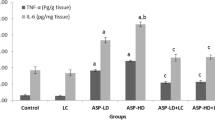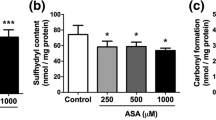Abstract
Pipecolic acid (PA) levels are increased in severe metabolic disorders of the central nervous system such as Zellweger syndrome, infantile Refsum disease, neonatal adrenoleukodystrophy and hyperlysinemia. The affected individuals present progressive neurological dysfunction, hypotonia and growth retardation. The mechanisms of brain damage of these disorders remain poorly understood. Since PA catabolism can produce H2O2 by oxidases, oxidative stress may be a possible mechanism involved in the pathophysiology of these diseases. Lipoic acid (LA) is considered an efficient antioxidant and has been shown to prevent oxidative stress in experimental models of many disorders of the neurologic system. Considering that to our knowledge no study investigated the role of PA on oxidative stress, in the present work we investigated the in vitro effects of PA on some oxidative stress parameters and evaluated the LA efficacy against possible pro-oxidant effects of PA in cerebral cortex of 14-day-old rats. The activities of catalase (CAT), glutathione peroxidase (GPx), glucose 6-phosphate dehydrogenase (G6PD), and glutathione S-transferase (GST) along with reduced glutathione (GSH) content were significantly decreased, while superoxide dismutase (SOD) activity and thiobarbituric acid-reactive substances (TBA-RS) were significantly enhanced by PA. LA was able to prevent these effects by improving the activity of antioxidant enzymes, increasing GSH content and reducing TBA-RS. In contrast, glutathione reductase and 6-phosphogluconate dehydrogenase activities and sulfhydryl content were not affected. Taken together, it may be presumed that PA in vitro elicits oxidative stress and LA is able to prevent these effects.





Similar content being viewed by others
References
Aebi H (1984) Catalase in vitro. Methods Enzymol 105:121–126
Aksenov MY, Markesbery WR (2001) Changes in thiol contet and expression of glutathione redox system genes in the hippocampus and cerebellum in Alzheimer’s disease. Neurosci Lett 302:141–145
Bast A, Haenen GR (2003) Lipoic acid: a multifunctional antioxidant. Biofactors 17:207–213
Baxter P (2003) Pyridoxine-dependent seizures: a clinical and biochemical conundrum. Biochim Biophys Acta 1647:36–41
Behl C, Moosmann B (2002) Antioxidant neuroprotection in Alzheimer’s disease as preventive and therapeutic approach. Free Radic Biol Med 33:182–191
Biewenga GP, Haenen GR, Bast A (1997) The pharmacology of the antioxidant lipoic acid. Gen Pharmacol 29:315–331
Broquist HP (1991) Lysine-pipecolic acid metabolic relationships in microbes and mammals. Annu Rev Nutr 11:435–448
Browne RW, Armstrong D (1998) Reduced glutathione and glutathione disulfide. Methods Enzymol 108:347–352
Calberg I, Manervik B (1985) Glutathione reductase. Methods Enzymol 113:484–49
Carter N, Pamba A, Duparc S et al (2011) Frequency of glucose-6 phosphate dehydrogenase deficiency in malaria patients from six African countries enrolled in two randomized anti-malarial clinical trials. Malar J 10:241
Cox RP (2001) Errors of Lysine metabolism. In: Scriver CR et al (eds) The metabolic and molecular bases of inherited disease, 8th edn. McGraw-Hill, New York, pp 1965–1970
Dickinson DA, Forman HJ (2002) Cellular glutathione and thiols metabolism. Biochem Pharmacol 64:1019–1026
Dickinson DA, Moellering DR, Iles KE et al (2003) Cytoprotection against oxidative stress and the regulation of glutathione synthesis. Biol Chem 384:527–537
Esterbauer H, Cheeseman KH (1990) Determination of aldehydic lipid peroxidation products: malonaldehyde and 4-hydroxynonenal. Methods Enzymol 186:407–421
Ezgu F, Eminoglu T, Okur I et al (2011) An infantile case of Zellweger syndrome presented with Kabuki-like phenotype. Genet Couns 22:217–220
Gérard-Monnier D, Chaudiere J (1996) Metabolism and antioxidant function of glutathione. Pathol Biol 44:77–85
Gutierrez MC, Delgado-Coello BA (1989) Influence of pipecolic acid on the release and uptake of [3H] GABA from brain slices of mouse cerebral cortex. Neurochem Res 14:405–408
Habig WH, Pabst MJ, Jacoby WB (1974) Glutathione S-Transferase: the first enzymatic step in mercapturic acid formation. J Biol Chem 249:7130–7139
Hagen TM, Ingersoll RT, Lykkesfeldt J et al (1999) (R)-α-lipoic acid-supplemented old rats have improved mitochondrial function, decreased oxidative damage, and increased metabolic rate. FASEB J 13:411–418
Halliwell B, Gutteridge JMC (2007) Free radicals in biology and medicine, 4th edn. Oxford University Press Inc., New York
Hashida K, Sakakura Y, Makino N (2002) Kinetic studies on the hydrogen peroxide elimination by cultured PC12 cells. Biochim Biophys Acta 1572:85–90
Inoue H, Sakata Y, Nishio H et al (2011) A simple and highly sensitive HPLC method with fluorescent detection for determination of pipecolic acid in mouse brain areas. Biol Pharm Bull 34:287–289
Ketterer B, Coles B, Meyer DJ (1983) The role of glutathione in detoxication. Environ Health Perspect 49:59–69
Kleinkauf-Rocha J, Bobermin LD, Machado PM et al (2013) Lipoic acid increases glutamate uptake, glutamine synthetase activity and glutathione content in C6 astrocyte cellline. Int J Dev Neurosci 31:165–170
Kletzien RF, Harris PKW, Foellmi LA (1994) Glucose 6-phosphate dehydrogenase: a “housekeeping” enzyme subject to tissue-specific regulation by hormones, nutrients and oxidant stress. FASEB J 8:174–181
Leong SF, Clark JB (1984) Regional enzyme development in rat brain. Enzymes associated with glucose utilization. Biochem J 218:131–138
Lissi E, Caceres T, Videla LA (1986) Visible chemiluminescence from rat brain homogenates undergoing autoxidation. I. Effect of additives and products accumulation. Free Radic Biol Med 2:63–69
Liu S, Baker JC, Andrews PC, Roche TE (1995) Recombinant expression and evaluation of the lipoyl domains of the dihydrolipoyl acetyltransferase component of the human pyruvate dehydrogenase complex. Arch Biochem Biophys 316:926–940
Lowry OH, Rosebrough NJ, Farr AL, Randall RJ (1951) Protein measurement with the folin phenol. J Biol Chem 193:265–275
Luzzatto L, Mehta A, Vulliamy T (2001) Glucose-6-phosphate dehydrogenase deficiency. In: Scriver CR et al (eds) The metabolic & molecular bases of inherited disease, vol 3. McGraw Hill, New York, pp 4517–4553
Manda G, Nechifor MT, Neagu TM (2009) Reactive oxygen species, cancer and anti-cancer therapies. Curr Chem Biol 3:342–366
Marí M, Morales A, Colell A et al (2009) Mitochondrial glutathione, a key survival antioxidant. Antioxid Redox Signal 11:2685–2700
Marklund SL (1985) Pyrogallol autoxidation. In: Greenwald RA (ed) CRC handbook of methods for oxygen radical research. CRC Press, Boca Raton, pp 243–247
Matalon R, Stumpf DA, Michals K et al (1984) Lipoamide dehydrogenase deficiency with primary lactic acidosis: favorable response to treatment with oral lipoic acid. J Pediatr 104:65–69
Mazzola PN, Karikas GA, Schulpis KH, Dutra-Filho CS (2013) Antioxidant treatment strategies for hyperphenylalaninemia. Metab Brain Dis 28:541–550
Meister A (1988) Glutathione metabolism and its selective modification. J Biol Chem 263:17205–17208
Moraes TB, Zanin F, Rosa A et al (2010) Lipoic acid prevents oxidative stress in vitro and in vivo by an acute hyperphenylalaninemia chemically-induced in rat brain. J Neurol Sci 292:89–95
Moraes TB, Jacques CE, Rosa AP et al (2013) Role of catalase and superoxide dismutase activities on oxidative stress in the brain of a phenylketonuria animal model and the effect of lipoic acid. Cell Mol Neurobiol 33:253–260
Muthuswamy AD, Vedagiri K, Ganesan M, Chinnakannu P (2006) Oxidative stress-mediated macromolecular damage and dwindle in antioxidant status in aged rat brain regions: role of L-carnitine and DL-alpha-lipoic acid. Clin Chim Acta 368:84–92
O’Brien ML, Tew KD (1996) Glutathione and related enzymes in multidrug resistence. Eur J Cancer 32:967–978
Packer L, Witt EH, Tritschler HJ (1995) Alpha-Lipoic acid as a biological antioxidant. Free Radic Biol Med 19:227–250
Packer L, Tritschler HJ, Wessel K (1997) Neuroprotection by the metabolic antioxidant alphalipoic acid. Free Radic Biol Med 22:359–378
Pederzolli CD, Rosa AP, de Oliveira AS et al (2010) Neuroprotective role of lipoic acid against acute toxicity of N-acetylaspartic acid. Mol Cell Biochem 344:231–239
Plecko B, Hikel C, Korenke GC et al (2005) Pipecolic acid as a diagnostic marker of pyridoxine-dependent epilepsy. Neuropediatrics 36:200–205
Roy S, Sen CK, Tritschler HJ, Packer L (1997) Modulation of cellular reducing equivalent homeostasis by alpha-lipoic acid. Mechanisms and implications for diabetes and ischemic injury. Biochem Pharmacol 53:393–399
Samuel S, Kathirvel R, Jayavelu T et al (2005) Protein oxidative damage in arsenic induced rat brain: influence of DL-a-lipoic acid. Toxicol Lett 155:27–34
Scott BC, Aruoma OI, Evans PJ et al (1994) Lipoic and dihydrolipoic acids as antioxidants: a critical evaluation. Free Radic Res 20:119–133
Seminotti B, Leipnitz G, Amaral AU et al (2008) Lysine induces lipid and protein damage and decreases reduced glutathione concentrations in brain of young rats. Int J Dev Neurosci 26:693–698
Seminotti B, Fernandes CG, Leipnitz G et al (2011) Neurochemical evidence that lysine inhibits synaptic Na+, K+-ATPase activity and provokes oxidative damage in striatum of young rats in vivo. Neurochem Res 36:205–214
Siddique YH, Ara G, Afzal M (2012) Estimation of lipid peroxidation induced by hydrogen peroxide in cultured human lymphocytes. Dose Response 10:1–10
Tew KD, Townsend DM (2012) Glutathione-s-transferases as determinants of cell survival and death. Antioxid Redox Signal 17:1728–1737
Tian WN, Pignatare JN, Stanton RC (1994) Signal transduction proteins that associate with the platelet-derived growth factor (PDGF) receptor mediate the PDGF-induced release of glucose-6-phosphate dehydrogenase from permeabilized cells. J Biol Chem 269:14798–14805
Wajner M, Latini A, Wyse AT, Dutra-Filho CS (2004) The role of oxidative damage in the neuropathology of organic acidurias: insights from animal studies. J Inherit Metab Dis 27:427–448
Wanders R et al (2001) Single peroxisomal enzyme deficiencies. In: Scriver CR et al (eds) The metabolic and molecular bases of inherited disease, 8th edn. McGraw-Hill, New York, pp 3219–3256
Wendel A (1981) Glutathione peroxidase. Methods Enzymol 77:325–332
Williams AC, Ford WCL (2004) Functional significance of the pentose phosphate pathway and glutathione reductase in the antioxidant defenses of human sperm. Biol Reprod 71:1309–1316
Zhang Z, Yang Z, Zhu B et al (2012) Increasing glucose 6-phosphate dehydrogenase activity restores redox balance in vascular endothelial cells exposed to high glucose. PLoS ONE. doi:10.1371/journal.pone.0049128
Ziegler D, Reljanovic M, Mehnert H, Gries FA (1999) Alpha-lipoic acid in the treatment of diabetic polyneuropathy in Germany: current evidence from clinical trials. Exp Clin Endocrinol Diabetes 107:421–430
Acknowledgments
This study was supported by the research grants from Conselho Nacional de Desenvolvimento Científico e Tecnológico (CNPq), Coordenação de Aperfeiçoamento de Pessoal de Nível Superior (CAPES), Fundação de Amparo à Pesquisa do Estado do Rio Grande do Sul (FAPERGS) and PROPESQ/UFRGS.
Conflict of interest
The authors declare that they have no conflict of interest.
Author information
Authors and Affiliations
Corresponding author
Rights and permissions
About this article
Cite this article
Dalazen, G.R., Terra, M., Jacques, C.E.D. et al. Pipecolic acid induces oxidative stress in vitro in cerebral cortex of young rats and the protective role of lipoic acid. Metab Brain Dis 29, 175–183 (2014). https://doi.org/10.1007/s11011-013-9466-3
Received:
Accepted:
Published:
Issue Date:
DOI: https://doi.org/10.1007/s11011-013-9466-3




